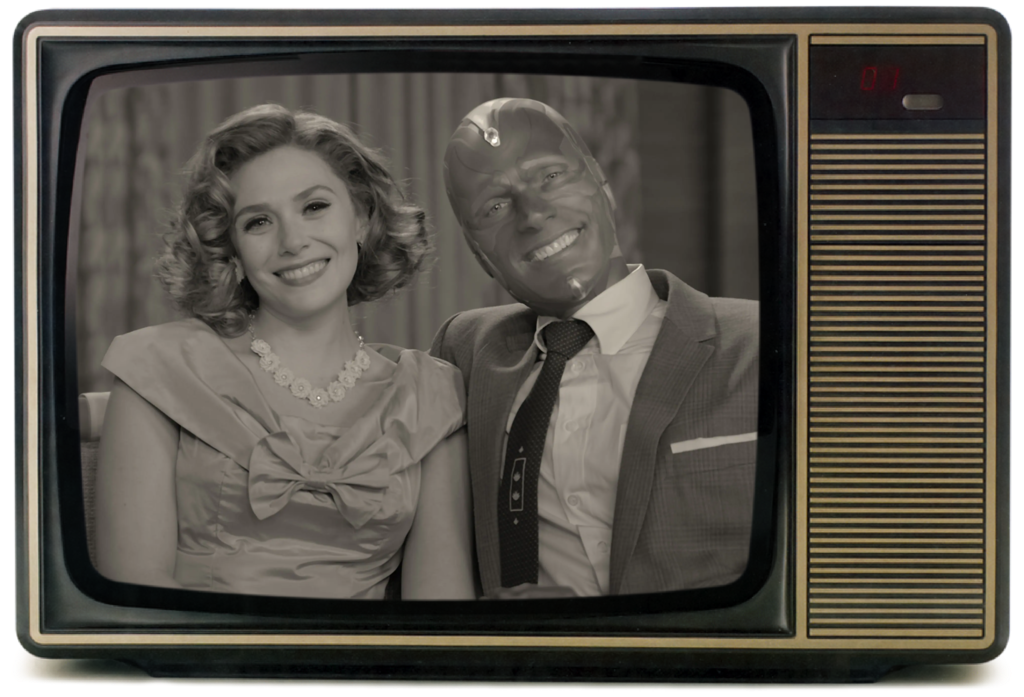REVIEW: ‘Wandavision,’ an homage to classic television with a dark twist

The first two episodes of the highly anticipated Marvel television miniseries “Wandavision” was released to Disney+ on Jan. 15 after over a year hiatus from new Marvel productions. Samantha deNicola | Daily Trojan.
This review contains spoilers.
The Marvel film franchise is well known for giving its superheroes astounding action scenes and heartfelt storylines, as seen in the one of the last major Marvel productions, “Avengers: Endgame.” The movie featured an epic fight scene with half the lives of the universe at stake, as well as gut-wrenching deaths of fan-favorite Avengers. It was a rollercoaster that’s the epitome of everything a Marvel production is expected to be.
Marvel’s first major crossover onto the smaller screen seems to break from the stereotypical mold present in “Endgame.” Last Friday, Marvel released the first two episodes of “Wandavision” on Disney+. The new series, which follows the Avengers’ Wanda and Vision, sets itself apart from the movies by starting as a sitcom set in the 1960s. The opening episodes’ black-and-white set design starkly contrasts with the super-saturated colors from the other Marvel movies.
Wanda and Vision present themselves as happy newlyweds who have just moved into their first home in the suburbs. It’s cute and it’s boring. Wanda serves the role of the dutiful housewife: cooking dinner, taking care of the home and meeting the other ladies on the block in her free time. In this perfectly tailored world, Vision heads to the office to work and tries to impress his boss. The lovely couple competes in a talent show and gossips with the other people in the neighborhood. It feels so normal that it’s easy to forget Wanda and Vision are superheroes and should not be living a mundane life in American suburbia. This storyline is a welcomed twist on Tom King’s “Vision” comic books, which sees Vision forced to live in the suburbs and cope with his sadness over not being human.
The show is essentially “The Truman Show” meets “The Dick Van Dyke Show” in an episode of the “Twilight Zone.”
The first episodes of the show transport the viewer back to an era of laugh tracks and exaggerated acting. It’s a far cry from the action-packed Marvel experiences the typical Marvel fan is accustomed to. However, the episodes, shot and presented as a stereotypical sitcom, hold mystery and allure.
It works largely because of its suspense.
The episodes continuously hint that there is a deeper, more paramount storyline that will be revealed later on in the season. Before the characters do, the audience learns that Wanda and Vision do not know the basic backstory of their life. (Episode 1, 18:00) Wanda gets hints that there is something abnormal about her reality, such as when she sees color for the first time (episode 2, 7:00) and hears someone calling out to her on the radio, asking if she is OK. (episode 2, 16:00)
The campy fun of the opening episodes is almost enough to obscure the deep sadness present in “Wandavision.” The world that Wanda and Vision are living in together isn’t real. In “Avengers: Infinity War,” Vision is killed when his life source, the mind stone, is taken from his forehead. In “Endgame,” the infinity stones were destroyed, and with them, any chance of Vision being brought back to life.
Vision is dead. And Wanda is grieving. She is in this state of limbo, unwilling to move along and let go of Vision. It is unknown whether she created the suburbia the show is set in, but, nevertheless, her desire for normalcy and a stable relationship with her deceased lover keeps her from questioning it too severely.
The absence of a villain allows Wanda to reject her superpowers and keep living in her peaceful fantasy. In episode two, Wanda steps outside and notices a man walking out of the sewers in a beekeeping costume staring menacingly at her. And instead of lifting her hands to use her magic, Wanda simply says “No.” (episode 2, 28:16). When she does so, the scene resets and Wanda goes back to playing house. She does not want to use her powers to fight and disrupt the normal peaceful life she has now.
“Wandavision” is a new way of looking at superheroes. It humanizes them. Marvel lets its superheroes come to terms with the awful carnage of their daily lives, just as the average person would need to do. Finally, Marvel is letting its superheroes grieve.


